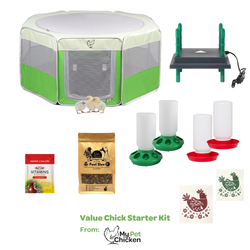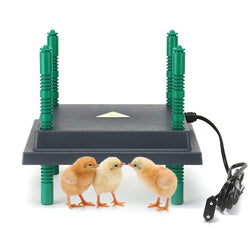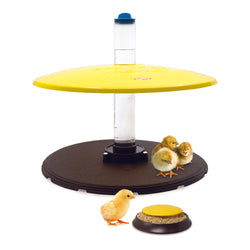What kind and how much feed should I give my flock at each stage of development?
Back to blog
As baby chicks and waterfowl grow, their nutritional needs change. It can be confusing to know how much and what kind of feed to give them at each stage of development. Please don't lose sleep over this issue! We have all the help you need for your growing chickens, ducks, and geese right here.
One note before we get started: All feed manufacturers have recommended stages for their feed. This guide is a commonly accepted standard; however, you should follow the directions on the feed you choose for optimum benefit from that brand.
Regardless of their age, one principle always applies: Always offer feeds to your flock "free choice," meaning they have access to feed at any time during their waking hours. Chickens won't overeat on quality, complete feeds (but do go take it easy on the treats), so giving them access to feed free choice will make sure they have all the nutrition they need without overfeeding them.
From Hatch to Around Six Weeks
Baby chicks need finely-milled chick starter feed. Laying breeds (most breeds we carry are this type) will eat about 1 pound of feed per chick each week. That means for baby chicks, you need about 6 pounds of feed per chick to reach the point where they switch to a grower/developer feed at around 6 weeks of age. Up to 6 weeks old, chicks need feed with 20%-22% protein for their rapidly growing bodies. Some flock keepers may choose to feed their chicks medicated starter feed. See our related article, What is medicated feed all about--do I need it? for information to help you determine if medicated feed is right for your chicks.

As long as they are only eating finely-milled chick starter feed, baby chicks do not need grit to help them digest their feed. In fact, some have found it wise not to give chicks grit until they are eating other foods in addition to chick feed. Baby chicks can sometimes mistake the grit for feed and consume too much, which can lead to digestive problems. Giving them nothing but chick starter feed for their first few weeks can help keep that from happening. As soon as you introduce other foods, however, make sure you give them access to chick grit as well, which will help them digest their feed.
Six Weeks to Laying Age
Juvenile chicks will need little over 1 pound of grower/developer feed per week until they start laying, usually somewhere between 16-24 weeks of age. This means you will need a little more than 8 pounds of grower/developer feed per juvenile. Birds from 6 weeks of age to point of lay need feed with 14%-16% protein. Please note that some brands of feeds to not have a grower or developer feed and go directly from starter to layer. Be sure to follow your feed brand's recommended feeding schedule.

Laying Adults
When laying, adult hens will eat about 1.5-1.75 pounds of layer feed each week. Once they have started laying, they need 15%-18% protein in their feed.
Roosters and Non-Laying Hens
Mature roosters and non-laying hens can continue to eat layer feed. However, some may choose to give their flock grower/developer feed during the fall and winter if the laying hens have substantially decreased the amount of eggs they are laying. If you choose to go with grower/developer feed in this circumstance, be sure to offer supplemental calcium in the form of crushed oyster shell so any hens that continue to lay will have enough calcium to form strong shells.
*Please note that the information in this article does not apply to Cornish Cross chickens. Cornish Crosses develop very quickly and require a different feed schedule.
From hatch to 2 weeks
Each duckling and gosling will eat about 1 pound of finely milled or crumble starter feed each week during the first two weeks of life. That means you will about need 3 pounds of feed per bird to reach the point where they switch to a grower/developer feed.
Like baby chicks, baby waterfowl do not need chick grit as long as they are eating water-soluble chick feed. To keep them from mistaking grit for feed, you may want to wait to offer them chick grit until they begin eating other food items and/or grower/developer feed around 3 weeks of age.

3 Weeks to Laying Age
Ducklings will need about 2-3 pounds of grower/developer feed per week until they start laying, usually somewhere between 24-26 weeks of age. This means you will need roughly 42-69 pounds of grower/developer feed per juvenile duckling. Goslings of this age will eat approximately 3 lbs of feed per week, or approximately 63-69 pounds per bird until they start laying eggs.
From 3 weeks until they produce their first egg, offer waterfowl grower crumble. Do not switch to layer pellets too early, as it can provide too much calcium for non-laying juveniles.
Laying Adults
Adult waterfowl will eat about 2-3 pounds of layer feed each week. While they are producing eggs, give them layer pellets.
Non-Laying Adults and Off-Season Layers
When they stop laying after breeding season, ducks can be fed 1-2 pounds of pelletized grower/developer feed each week, and geese can receive about 3 pounds each week. If unavaialable, you can keep them on layer pellets.
Remember, feed should be offered free choice at all times. Geese will tend to supplement their intake with pasture if available. Ducks greatly enjoy bugs, frogs, and some pasture as well.
One note before we get started: All feed manufacturers have recommended stages for their feed. This guide is a commonly accepted standard; however, you should follow the directions on the feed you choose for optimum benefit from that brand.
Regardless of their age, one principle always applies: Always offer feeds to your flock "free choice," meaning they have access to feed at any time during their waking hours. Chickens won't overeat on quality, complete feeds (but do go take it easy on the treats), so giving them access to feed free choice will make sure they have all the nutrition they need without overfeeding them.
Chicken Feeding Guide
From Hatch to Around Six Weeks
Baby chicks need finely-milled chick starter feed. Laying breeds (most breeds we carry are this type) will eat about 1 pound of feed per chick each week. That means for baby chicks, you need about 6 pounds of feed per chick to reach the point where they switch to a grower/developer feed at around 6 weeks of age. Up to 6 weeks old, chicks need feed with 20%-22% protein for their rapidly growing bodies. Some flock keepers may choose to feed their chicks medicated starter feed. See our related article, What is medicated feed all about--do I need it? for information to help you determine if medicated feed is right for your chicks.

As long as they are only eating finely-milled chick starter feed, baby chicks do not need grit to help them digest their feed. In fact, some have found it wise not to give chicks grit until they are eating other foods in addition to chick feed. Baby chicks can sometimes mistake the grit for feed and consume too much, which can lead to digestive problems. Giving them nothing but chick starter feed for their first few weeks can help keep that from happening. As soon as you introduce other foods, however, make sure you give them access to chick grit as well, which will help them digest their feed.
Six Weeks to Laying Age
Juvenile chicks will need little over 1 pound of grower/developer feed per week until they start laying, usually somewhere between 16-24 weeks of age. This means you will need a little more than 8 pounds of grower/developer feed per juvenile. Birds from 6 weeks of age to point of lay need feed with 14%-16% protein. Please note that some brands of feeds to not have a grower or developer feed and go directly from starter to layer. Be sure to follow your feed brand's recommended feeding schedule.

Laying Adults
When laying, adult hens will eat about 1.5-1.75 pounds of layer feed each week. Once they have started laying, they need 15%-18% protein in their feed.
Roosters and Non-Laying Hens
Mature roosters and non-laying hens can continue to eat layer feed. However, some may choose to give their flock grower/developer feed during the fall and winter if the laying hens have substantially decreased the amount of eggs they are laying. If you choose to go with grower/developer feed in this circumstance, be sure to offer supplemental calcium in the form of crushed oyster shell so any hens that continue to lay will have enough calcium to form strong shells.
*Please note that the information in this article does not apply to Cornish Cross chickens. Cornish Crosses develop very quickly and require a different feed schedule.
Waterfowl Feeding Guide
From hatch to 2 weeks
Each duckling and gosling will eat about 1 pound of finely milled or crumble starter feed each week during the first two weeks of life. That means you will about need 3 pounds of feed per bird to reach the point where they switch to a grower/developer feed.
Like baby chicks, baby waterfowl do not need chick grit as long as they are eating water-soluble chick feed. To keep them from mistaking grit for feed, you may want to wait to offer them chick grit until they begin eating other food items and/or grower/developer feed around 3 weeks of age.

3 Weeks to Laying Age
Ducklings will need about 2-3 pounds of grower/developer feed per week until they start laying, usually somewhere between 24-26 weeks of age. This means you will need roughly 42-69 pounds of grower/developer feed per juvenile duckling. Goslings of this age will eat approximately 3 lbs of feed per week, or approximately 63-69 pounds per bird until they start laying eggs.
From 3 weeks until they produce their first egg, offer waterfowl grower crumble. Do not switch to layer pellets too early, as it can provide too much calcium for non-laying juveniles.
Laying Adults
Adult waterfowl will eat about 2-3 pounds of layer feed each week. While they are producing eggs, give them layer pellets.
Non-Laying Adults and Off-Season Layers
When they stop laying after breeding season, ducks can be fed 1-2 pounds of pelletized grower/developer feed each week, and geese can receive about 3 pounds each week. If unavaialable, you can keep them on layer pellets.
Remember, feed should be offered free choice at all times. Geese will tend to supplement their intake with pasture if available. Ducks greatly enjoy bugs, frogs, and some pasture as well.



